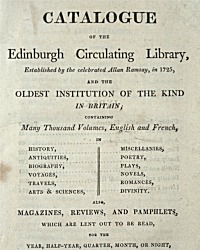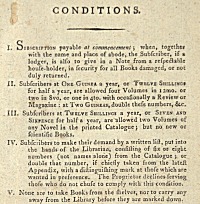Contents ![]() | Introduction
| Introduction ![]() | Institutes of learning
| Institutes of learning ![]()

Circulating libraries
Page 1 of 2 | Next
Circulating libraries were commercial ventures, often run by booksellers as a sideline. In Edinburgh, the Scottish Enlightenment influenced both circulation and subscription libraries. The earliest circulating library in Edinburgh was that of Allan Ramsay (1684-1758), which he opened in 1725. Unlike subscription libraries the customers had no input regarding the choice of books bought for the library and they played no role in its management. By 1800 there were, or had been, around 8 in Edinburgh and Leith, others at Haddington and Dunbar, and another 20 in Scotland's cities and larger towns. Their stock was largely non-fiction, but theology was diluted by history, geography, and science and technology. Some circulating libraries had large amounts of classic literature. Borrowers usually paid to join and they paid to borrow.

Their success of circulating libraries depended upon the skill of the owner or his successors. Some Edinburgh libraries can be traced through several hands. Ramsay's original library in Edinburgh was sold in 1857 to John Yair. In 1780 Yair's widow sold it to James Sibbald. Sibbald's brother and executor sold it to Alexander Mackay in 1806. More than a century after it was first founded in the 1850s Mackay disposed of it at auction. Amongst others in Edinburgh were:
Lawrie's Edinburgh Circulating Library was based at Parliament Close and around 1800 had thousands of books, including some written in languages other than English. A customer had to pay one guinea annually to be allowed to borrow a certain number of books. If they wished to borrow more they had to pay more.
Page 1 of 2 | Next
In this section:
Circulating libraries | Subscription libraries | Itinerating libraries | Free public libraries
Contents ![]() | Introduction
| Introduction ![]() | Institutes of learning
| Institutes of learning ![]()